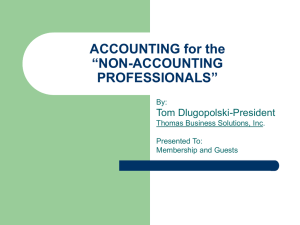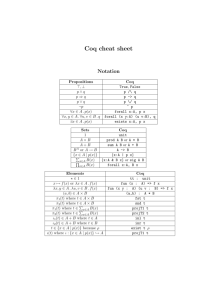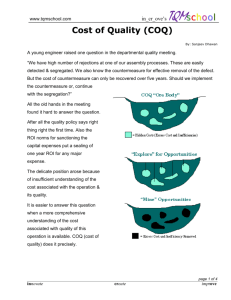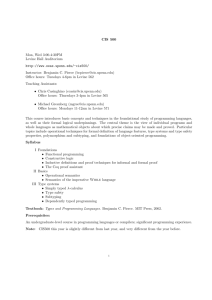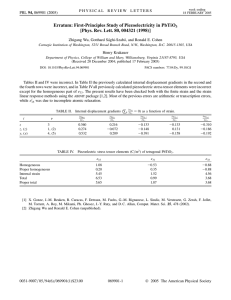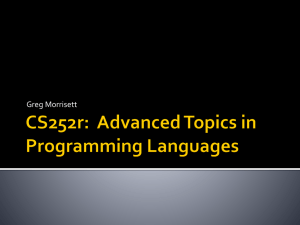Martin Henz and Aquinas Hobor School of Computing National University of Singapore
advertisement
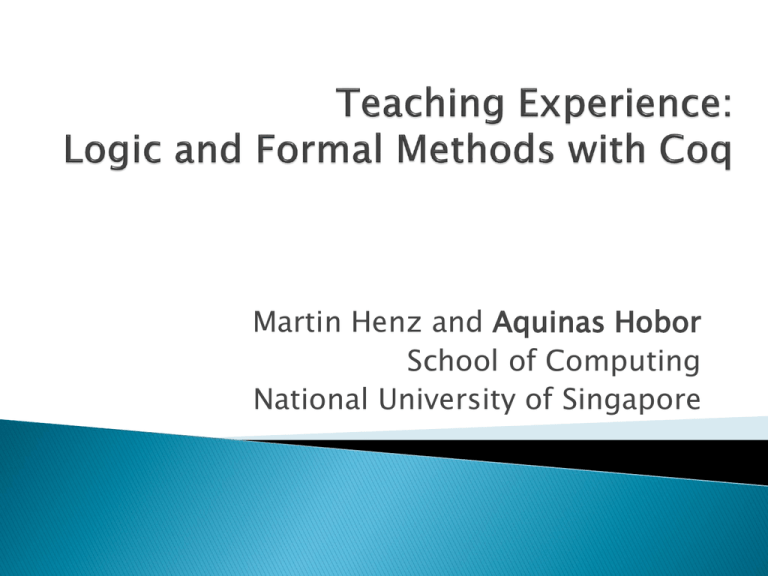
Martin Henz and Aquinas Hobor School of Computing National University of Singapore 2 YOU ARE ABOUT TO HEAR THE LEAST TECHNICAL TALK AT CPP / APLAS 2011 3 Propositional Logic Predicate Logic Induction Modal Logic Hoare Logic 4 5 What do the students say? 6 What do the students say? Hard and very abstract 7 What do the students say? Hard and very abstract Dry and boring 8 What do the students say? Hard and very abstract Dry and boring Removed from applications 9 What about introducing tool support? 10 What about introducing tool support? How can a tool help address some of our problems? 11 A partial win Students often do not know when a proof is correct – tools help with this problem a lot On the other hand, topic is still abstract Also, the students now have to learn how to use the tool – makes their job harder 12 A major win Students in computer science enjoy using computers! Some tools can be a lot of fun to use Building [Coq] scripts is surprisingly addictive, in a videogame kind of way… [Xavier Leroy, 2005] 13 A partial win Students appreciate getting hands on a tool We can bring up success stories for that tool But we have found that it is not enough – we adjust by trying to bring up other example applications as we go through the curriculum 14 There are lots of tools out there: SAT solvers, model checkers, proof assistants, program verifiers, … There is a cost to learn each tool Breadth vs. Depth tradeoff Coq is useful for almost the entire course 15 See our paper! We have also produced a (very much in progress, alpha) series of lecture notes (~80 pages) on the basic topics we cover: www.comp.nus.edu.sg/~henz/cs3234 For the rest of this talk I am going to cover a few highlights, lowlights, and options we have explored. 16 Start with something that may be more familiar: syllogisms Syntax vs. semantics, proof theory (natural deduction), semantic arguments (models) Introduce Coq With Notation you can write things like, All Greeks are humans. in Coq! 17 Semantics is naive set theory (Venn diagrams) Good puzzles from Lewis Carroll: 18 Semantics is naive set theory (Venn diagrams) Good puzzles from Lewis Carroll: 1. No ducks waltz. 19 Semantics is naive set theory (Venn diagrams) Good puzzles from Lewis Carroll: 1. No ducks waltz. 2. No officers ever decline to waltz. ½ 20 Semantics is naive set theory (Venn diagrams) Good puzzles from Lewis Carroll: 1. No ducks waltz. 2. No officers ever decline to waltz. 3. All my poultry are ducks. ½ 21 Semantics is naive set theory (Venn diagrams) Good puzzles from Lewis Carroll: 1. No ducks waltz. 2. No officers ever decline to waltz. 3. All my poultry are ducks. It should be obvious that: No officers are my poultry. 2 22 We find it useful to cover propositional logic in Coq twice We first cover it encoded as a datatype Inductive Formula : Type := | AndForm : Formula -> Formula -> Formula … We provide a module signature with the axioms of propositional logic 23 We have them prove simple facts via those axioms (in a module functor). We point out that the tactics they have been using (e.g., split) are similar to axioms in the module signature (e.g., conj_i) We find this approach helps students understand the distinction between object logic and meta logic. 24 Teaching with Coq becomes a bit entwined with teaching Coq. To a typical third-year undergraduate student, Coq is remarkably close to voodoo. Poor error messages don’t help matters… This tends to cause undue hacking, etc. 25 We have found the following form of diagram useful when explaining tactics to students: 26 It is extremely useful to demonstrate binder management via Coq. That is, use “rewrite” tactic to show Coq handles variable capture, etc. Paper proofs improved once they could try such things out in the theorem prover. 27 Students usually have a very hard time understanding induction on paper. Coq handles induction beautifully. We saw a significant increase in comprehension vs. prior years in understanding induction. Their paper proofs improved a lot as a result! 28 Coq does not directly support natural deduction proofs in modal logic. Best [de Wind ‘01]. Still not much fun. Semantic style: use modal operators to express theorems, but often have to unfold definitions to prove them. 29 We did get some benefits from using Coq. We covered a kind of higher-order multimodal logic. One benefit was that we were able to investigate correspondence theory in Coq. 30 Concrete program verification in Coq is extremely painful. Maybe better tactics would help, or some other clever tricks… not sure. We had to assign virtually all of the concrete verifications by hand. Instructors used Coq to debug Huth & Ryan. Maybe it would be valuable to add a second tool. 31 We had more success on the semantic side of Hoare logic – usually ignored in courses. Used a “dynamic logic” approach to define the Hoare tuple via modal logic. If you set things up just right, the students can prove the soundness of a simple Hoare logic (both partial and total) in Coq! 32 Custom tactics: we tried it, most of the time we avoid it now. Homework: we try to assign some of the same problems both in Coq and on Paper. Applications: we discuss several (sports tournament scheduling, network security analysis, etc.). 33 Takes significant experimentation to find the right definitions. Running this course took a lot of time. Hopefully as the notes become more polished this will be reduced. Cheating: it’s an issue. Our final exams are done in the lab and are 40% in Coq. 34 “I would like to thank you for the Automated Theorem Prover (Coq) you taught in CS5209 course. It makes life easy while trying to prove theorem as compared to paper part. In addition to this it saves life of student in Final exam. In the beginning for the course I hated Coq a lot, but slowly I start liking it as I understood the way tactic works and how to use them. Now it has become most favorite and interesting part of mine in this course.” (2009/2010) 35
